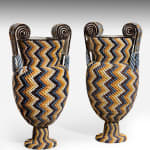Pair of Terraglia ‘Mosaic’ Volute-Krater Vases
ITALY, circa 1826-30
67.5 x 36 x 29 cm
Further images
-
(View a larger image of thumbnail 1
)

-
(View a larger image of thumbnail 2
)

-
(View a larger image of thumbnail 3
)

-
(View a larger image of thumbnail 4
)

-
(View a larger image of thumbnail 5
)

-
(View a larger image of thumbnail 6
)

-
(View a larger image of thumbnail 7
)

-
(View a larger image of thumbnail 8
)

-
(View a larger image of thumbnail 9
)

-
(View a larger image of thumbnail 10
)

-
(View a larger image of thumbnail 11
)

These vases belong to a remarkable and rare group of terraglia or creamware wares of a technique unique to the Giustiniani factory and said to be inspired by the coloured tessera of antique mosaics. These appear to be the largest recorded examples of the group.
Only a few other examples are known. A single vase of calyx-krater form in the Museo Artistico Industriale di Napoli, measuring 37cm tall is illustrated in Mario Rotili’s ‘La Manifattura Giustiniani’ (Museo del Sannio, 1967), plate XXIV and again in Guido Donatone’s ‘La Terraglia Napoletana’ (1991), plate 156. A pair of amphora vases were on the London art market in the early 1990s.
A desk set in a similar technique formed as an Inkwell, pounce pot and chamber stick on a tray made from ‘various pieces of pottery mimicking mosaic’ was presented for the first time at the 1826 Exhibition from Fabbrica di Biagio Giustiniani. It is illustrated in ‘La Terraglia Napoletana’, Guido Donatone, 1991, colour plate 20a.
Giustiniani family: The Giustiniani factory was established in Naples in the second half of the 18th Century by a family of potters and, under the management of Biagio Giustiniani, had, by 1820 to 1840, grown to employ 60 skilled artists and 120 other workers. Under Biagio, the factory had become famous for its products inspired by the excavated wares of Pompeii and Herculaneum. The family produced utilitarian earthenwares, teracotta garden wares, reproduction antique vases, plates and porcelain. The work which they produced was highly regarded and was awarded prizes at both national and international exhibitions. They also decorated their artefacts with local scenes and figures in traditional costume.
The bold zigzags of colour in relief are unparalleled in any other ceramics of the period. A possible source of these bold zigzag designs might be mosaics from Pompeii or Herculaneum. We have found a similar pattern in a Roman mosaic from Ravenna and in an 8th Century Umayyad mosaic at Khirbat Al-Mafjar, north of Jericho.
We are grateful to Errol Manners for his help with cataloguing these vases.











